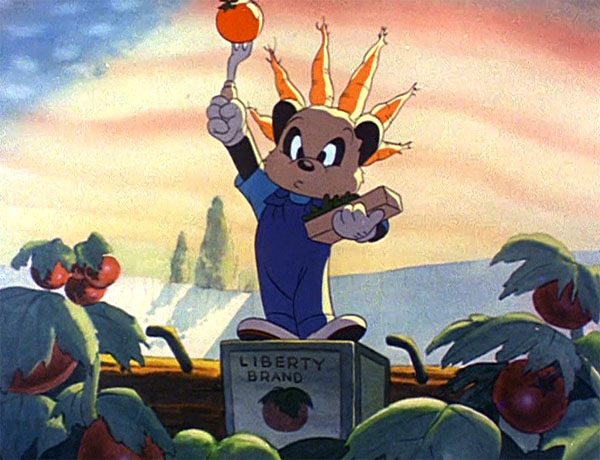
For this special post in November — it might not be turkey, but it sure is fowl! For the first time in a long while on Cartoon Research, here is an animator breakdown of a Walter Lantz Cartune featuring Andy Panda…
To give proper context to the cartoon’s title and subject, its opening shot, which shows Andy Panda’s mailbox stuffed to overflowing with booklets and papers, relates to the “Meatless Tuesday” decree American households adopted during World War II. The notion of “Meatless Tuesday” originated in the First World War, with citizens asked to reduce their consumption of meat. In addition, families were also encouraged to participate in Wheatless Mondays and Wednesdays. Other foods such as sugar, butter and fats were also rationed during the Great War.
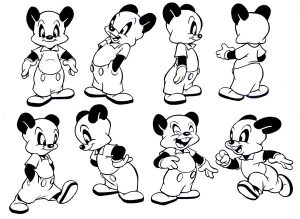 These wartime restrictions are indicated by the contents of Andy’s mailbox. Inside are ration books, which contained stamps for consumers to purchase high-demand items, such as meat, issued as “points.” Also seen is a message from the O.P.A. (Office of Price Administration), which controlled prices and enforced the rationing policies during the war. Starting in April 1942, sugar was rationed, with coffee rationed in November. By October 1942, the American government ruminated over meatless days for American families to aid the war effort. Meatless days already became a fixture in restaurants, at least in New York, but regardless, this news warranted topical gags in animated cartoons about relevant events in relation to food shortages and rationing.
These wartime restrictions are indicated by the contents of Andy’s mailbox. Inside are ration books, which contained stamps for consumers to purchase high-demand items, such as meat, issued as “points.” Also seen is a message from the O.P.A. (Office of Price Administration), which controlled prices and enforced the rationing policies during the war. Starting in April 1942, sugar was rationed, with coffee rationed in November. By October 1942, the American government ruminated over meatless days for American families to aid the war effort. Meatless days already became a fixture in restaurants, at least in New York, but regardless, this news warranted topical gags in animated cartoons about relevant events in relation to food shortages and rationing.
Coincidentally, on the date of March 29, 1943, two significant events occurred: meats such as beef, pork, lamb, veal, and canned meats were now added on the list of rationed goods—poultry, fish and eggs were exceptions, suggested as recipes in Andy Panda’s cookbook at the start of the cartoon. That same day, Shamus (James) Culhane was added to the payroll at Walter Lantz’s studio as a director, after having left Leon Schlesinger’s studio due to an altercation over the Private SNAFU films. (The date of Culhane’s arrival is sourced from Joe Adamson’s personnel notes, relayed by Lantz’s accountant Bob Miller.) Culhane started on two cartoons in the Swing Symphonies series. Meatless Tuesday was his first production with an established Lantz character.
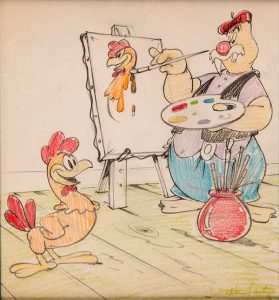 The character of Andy Panda did not interest the new director, which he deemed “too goddamn sweet and cuddly” in his autobiography Talking Animals and Other People. A comparison to another wartime Lantz production, Andy Panda’s Victory Garden, directed by Alex Lovy and released September 1942, shows the blatant differences between both directors. Lovy’s cartoon has a lethargic pace. The Lantz studio’s output improved substantially in this, Culhane’s third cartoon as a director, in terms of cutting, timing and character designs. In a wise directorial decision, the cartoon is told through pantomime, so Andy does not speak superfluous dialogue, as he did in Victory Garden.
The character of Andy Panda did not interest the new director, which he deemed “too goddamn sweet and cuddly” in his autobiography Talking Animals and Other People. A comparison to another wartime Lantz production, Andy Panda’s Victory Garden, directed by Alex Lovy and released September 1942, shows the blatant differences between both directors. Lovy’s cartoon has a lethargic pace. The Lantz studio’s output improved substantially in this, Culhane’s third cartoon as a director, in terms of cutting, timing and character designs. In a wise directorial decision, the cartoon is told through pantomime, so Andy does not speak superfluous dialogue, as he did in Victory Garden.
What the two films share is an unnamed rooster character—a nuisance in Lovy’s cartoon, but a persecuted animal for Andy’s potential dinner in Culhane’s film. While the picture was in production, the character literally hatched into the concurrent series of Andy Panda comic book stories, running principally at the time in New Funnies. The Andy comics were at the time transitioning from featuring Andy as a talking bear in a world of humans to Andy as a funny animal in the fully anthropomorphic “Lantzville,” and new writer John Stanley evidently thought the rooster in Meatless Tuesday might make a perfect sidekick. First debuting as a newborn chick in issue #79 (September 1943), Charlie Chicken grew over the following two issues into an approximation of his Meatless Tuesday design, with the distinction of speaking English in a wisecracking tone. Andy was fairly uncharismatic as a comics lead—an odd mix of wide-eyed kid and nervous fuddy-duddy—but as written by Stanley, Charlie made an ideal foil. His sidekick position instantly became permanent, lasting in comic book stories—and some reprints—into the early 1990s.
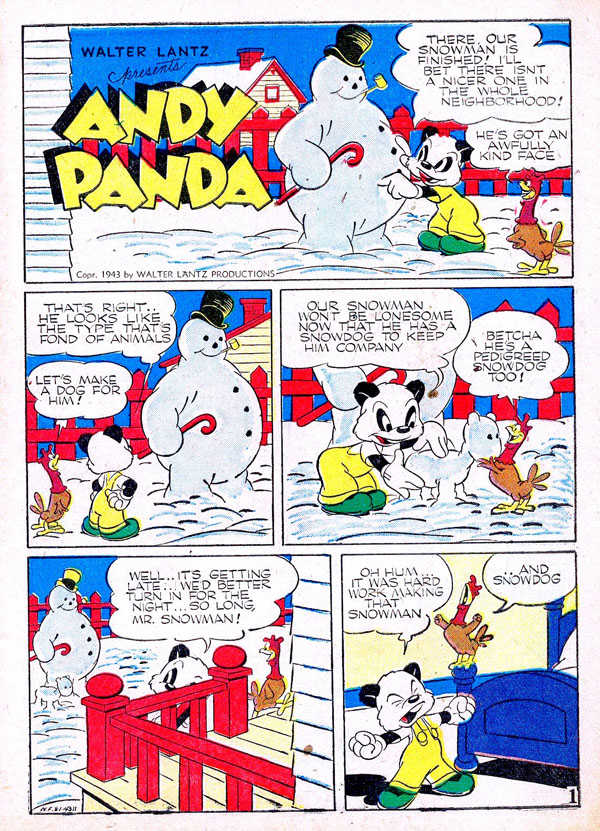
From NEW FUNNIES #81 (Nov. 1943), courtesy of Frank M. Young
Starting in 1942, Andy Panda appeared solo in Good-Bye Mr. Moth, after his father Poppa Panda was retired from the series. In the following cartoon Nutty Pine Cabin, Andy entered maturity and became a domesticated straight man in his cartoons, in contrast to the studio’s raucous breakout star Woody Woodpecker. Besides Victory Garden, Andy was cast as an American citizen doing his bit in Air Raid Warden, and appeared in the spot-gag cartoon Canine Commandos, where he is seen working in a boot camp populated by buck private hounds. In Meatless Tuesday, he is an indignant consumer frustrated over the dietary regulations during wartime, in the introductory scenes animated by Laverne (Verne) Harding.
Scene 8, which introduces the rooster as he proudly crows and struts on top of a chicken coop before spotting Andy with the net, is assigned to Verne Harding in the production draft. However, the animation in the scene is identical to the work in scene 47, credited to Les Kline. Though it is uncertain, it’s possible Culhane decided to lift Kline’s animation from the later scene as a cost-cutting measure, given the lower budgets the studio was allotted. The animation of the rooster backing away from Andy in scene 11, credited to Verne Harding, does not match the earlier scene in its drawing. It might have originally been assigned with Harding in mind, before the decision was made to reuse footage, hence the credit in the draft.
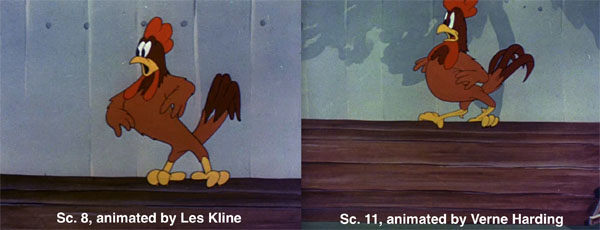
An astonishing discovery in the production draft for Meatless Tuesday is a credit for an artist known as “Busch,” which refers to animator Paul Busch (1909-1980). Busch worked at Walt Disney’s studio as an animator on Snow White and the Seven Dwarfs (in Ham Luske’s unit), Pinocchio and Fantasia. He left Disney to work for Consolidated Steel designing safety posters, and presumably received a job from Lantz some time later. It is unclear how long he stayed at Lantz’s studio, but it might have been relatively brief, as he is not credited in the films. He moved to New York to work at Famous Studios, where he is credited in the Little Lulu cartoon Hullaba-Lulu (1944, de-facto directed by Graham Place). He did not stay long at Famous, either; he became an art director at Willard Pictures on training films for the Navy.
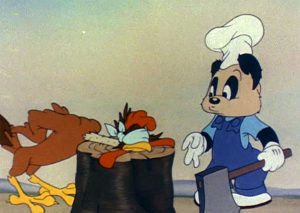 The production draft also reveals that an artist credited as “Rudy” appears in another 1940s Lantz production. Since Rudolph (Rudy) Larriva had been working at Warner Bros. during the period, it is safe to say the animator is Rudy Zamora, who worked with Culhane in the early 1930s at Max Fleischer and Ub Iwerks’ studio, respectively. Zamora had worked at Lantz’s studio in the mid-1930s as an animator and as director on two 1938 releases, but like Paul Busch, he was never credited in subsequent films, so it can be assumed this second stint was also short-lived. As a former colleague of Culhane’s, it seems logical Zamora was entrusted with the extended sequence of Andy ready, but hesitant, to decapitate the rooster on the chopping block. Shortly after, Zamora animated on The Barber of Seville, Culhane’s first cartoon with Woody Woodpecker, where he animates the entirety of Woody’s interaction with the Native American chief.
The production draft also reveals that an artist credited as “Rudy” appears in another 1940s Lantz production. Since Rudolph (Rudy) Larriva had been working at Warner Bros. during the period, it is safe to say the animator is Rudy Zamora, who worked with Culhane in the early 1930s at Max Fleischer and Ub Iwerks’ studio, respectively. Zamora had worked at Lantz’s studio in the mid-1930s as an animator and as director on two 1938 releases, but like Paul Busch, he was never credited in subsequent films, so it can be assumed this second stint was also short-lived. As a former colleague of Culhane’s, it seems logical Zamora was entrusted with the extended sequence of Andy ready, but hesitant, to decapitate the rooster on the chopping block. Shortly after, Zamora animated on The Barber of Seville, Culhane’s first cartoon with Woody Woodpecker, where he animates the entirety of Woody’s interaction with the Native American chief.
John Richard (Pat) Matthews is given screen credit on the main titles with Paul Smith, but the production draft reveals he animated very little footage in the cartoon. Matthews’ elastic drawing/animation earmarks can be seen when the rooster and hens move their coop to a garden pond, culminating an extended “switcheroo” sequence by Paul Smith. Matthews is also credited on the reaction shots of the hens during the chase scenes of Andy and the rooster, along with Zamora’s sequence at the chopping block. Though Matthews animated in Culhane’s previous release Boogie Woogie Man, his strengths as an animator fully emerged at the studio with the scenes of the titular character and the sultan’s daughter in The Greatest Man in Siam, the next production that followed after this cartoon.
After the film’s announced release on October 25th, 1943, Culhane, as the sole director of Lantz’s cartoons, needed to expand his animation staff. On November 1st, animators Dick Lundy and Grim Natwick were added to the payroll; Variety mentioned Don Williams was added to the staff by October 28, as was Natwick, but it can be assumed all three artists were official employees on the date Lantz’s payroll records indicate. During the holiday season, Meatless Tuesday played at the Criterion Theater in New York on December 20th, with the Universal feature Crazy House, with the comedic duo of Ole Olsen and Chic Johnson. In sharing these materials with cartoonist/animator Mike Kazaleh, he responded with an amusing memory: “I will never forget what happened to this cartoon on WKBD channel 50. They would cut out parts of the cartoon for time, then splice them back in for subsequent airing. Once they cut a large section of the middle of Meatless Tuesday out, and the next time they aired it, the sequence was put back in…upside-down and backwards.” What a fowl-up!*
*Apologies for the double dosage of “fowl” puns in relation to this picture. (On second thought, upon closer reading, make that triple!!)
Enjoy!
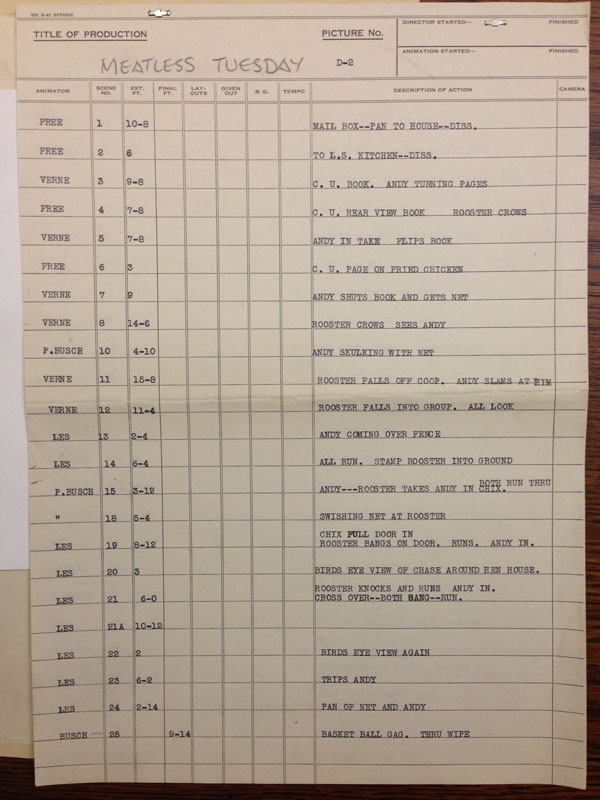
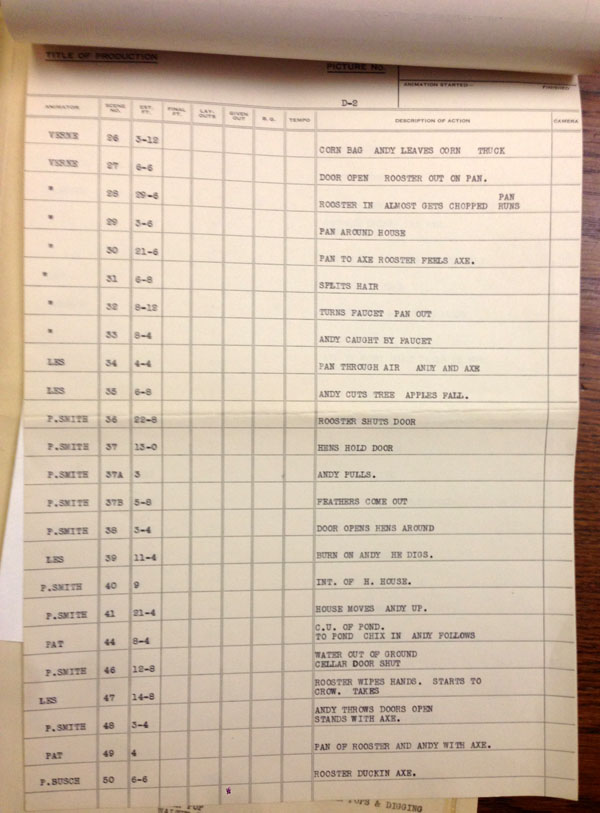
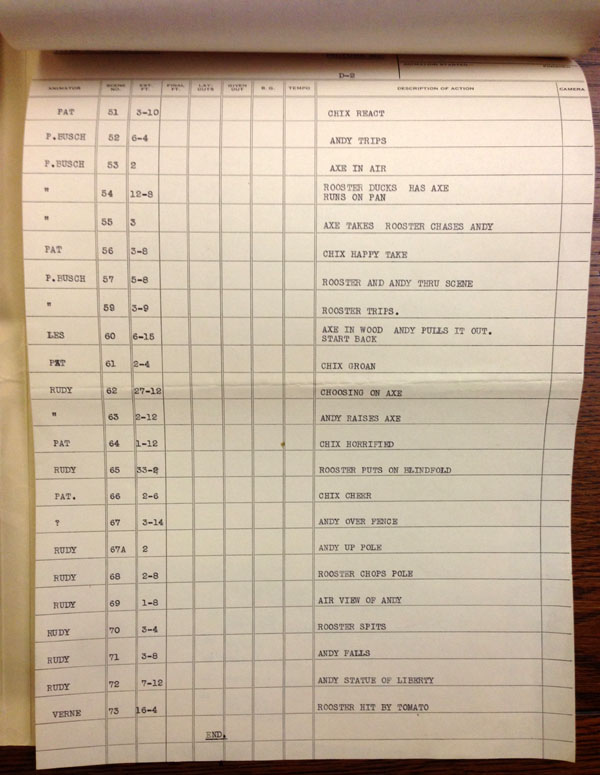
(Thanks to Tom Klein, Joe Adamson, Michael Barrier, Eric Costello, Frank M. Young, David Gerstein and Steven Hartley for their help.)


 DEVON BAXTER is a film restoration artist, video editor, and animation researcher/writer currently residing in Pennsylvania. He also hosts a
DEVON BAXTER is a film restoration artist, video editor, and animation researcher/writer currently residing in Pennsylvania. He also hosts a 





















































































A “wonder-fowl” post! Thanks especially for including links to all the cartoons you cited in this article. It not only makes for a very entertaining Andy Panda-thon, but also illustrates the points you’ve made about the development of the character and of the Lantz studio in general during this period.
I found it interesting to compare Darrell Calker’s musical scores to “Victory Garden” and “Meatless Tuesday”. In both cartoons he uses rapid chromatic runs in the violins, repeated as an ostinato, during the chase sequences. However, in “Victory Garden”, where it takes forever for anything to happen, there’s a lot more repetition of this pattern, alternating with long held notes in the brass; the music keeps stopping and starting without getting anywhere. Whereas in “Meatless Tuesday”, the chromatic runs serve as counterpoint to musical figures that accentuate the action. It seems as though the improved timing and gags of the latter cartoon opened up greater musical possibilities for the composer.
I couldn’t help noticing the bright red irises in Andy’s yard. No one has ever succeeded in breeding an iris of such a vivid red; shades of mauve or magenta are as close as anyone has ever got. Andy should enter them in a flower show, as Little Lulu’s dad did with his blue dahlia in “Daffy Dilly Daddy”.
In the “Crazy House” trailer, the dancer who yells “Okay, boys, I’ll take a chance!” is Cass Daley, whom Friz Freleng parodied as Little Red Riding Hood in his 1944 cartoon “Little Red Riding Rabbit”.
I was a very devoted viewer of cartoons on Detroit’s WKBD Channel 50, but I don’t recall ever seeing this cartoon with any upside-down scenes. Wish I had!
I have fond memories of watching Lantz cartoons on WKBD in the 1970s, but I missed that incident. Any idea of the time frame in which it occured?
(I recall the Warner cartoon HYDE AND HARE being mangled in a similar manner by channel 50 – somehow the opening shot was spliced in _twice_, repeating itself!)
Imagine people today reacting to the concept of “Meatless Tuesdays”, even if it’s just a suggestion rather than a mandate. “The Gov’ment can’t tell me when I can and cannot eat meat!”
Some nice character work from Harding on the scenes where the rooster escapes getting his head chopped off, with him checking his neck for blood, then eyeing suspiciously the feed Andy puts in as bait. You rarely see this type of personality business in cartoons anymore, even on feature films.
11/17/20
RobGems68 Wrote:
I don’t remember this Andy Panda cartoon being shown upside down on Channel 50’s time slots when I was a kid growing up in Pontiac, Michigan, either, but I do remember them showing so many bad edits and chopped-out scenes (if there was a blackface gag, for instance, as Channel 50 had some black staff members and some mixed-race ones (like anchor woman Amyre Makupson), so there must have been some offended or hurt feelings at the time to butcher up these fine cartoons. Also chopped out was any overtly-violent scenes (such as suicide, though they did allow a suicide-driven themed cartoon like “Mousie Come Home” to slip by the censor’s scissors.) Whenever these botched-up film prints (always seemed like 16-mm prints, which were easy to wear-and-tear) would break or get something stuck (like a arm hair) in the projector, they had to put up a title still, with some spooky announcer saying “One moment, please.” This would last until nearly a minute or so until the projectionist got the film back on track. Very sloppy and amateurish, and it always annoyed me as a child. I Hated that announcer’s voice, whoever he was (some sources from Field Communications info say it may have been Donald “Dr. Don” Rose, who also put out some repetitious sound bite announcing during the cartoon hours on Channel 50, but this I’m not certain. Maybe Paul Groh knows who it was. they also had bad habits at Channel 50 like butchering up Old 3 Stooges Shorts (even after midnight hours), skipping such fine Woody Woodpecker episodes (never once did I see “Barber Of Seville” on Channel 50’s roster, in fact, it wasn’t until the late 80’s that I saw this famous cartoon once Channel 50’s main UHF rival, Channel 20 (WXON) started showing the Woody Woodpecker cartoons-perhaps Channel 50 thought that it was too sadistic? There WAS I always thought a possible mean spirited streak in Woody (and Jerry The Mouse) at the time.) The worst one of all is around 1978, when Channel 50 switched their affiliations from Kaiser Broadcasting to Field Communications, chopped out their opening and closing logo placements with Field Communications’ own annoying logo and theme. For example, after 1978, I started really missing the “Universal Globe Logo” at the beginning of the Woody Woodpecker episodes as much as I missed the Screen Gems Dancing Sticks or “S From Hell ” logos at the end of every Flintstones episodes. The term “Meatless Tuesday’ wouldn’t mean anything to today’s generation, unless your parents are strict vegetarians, then it would be “No Meat any day of the week.” The closest source I got as a kid was from my Grandfather Dick Meyers, who served in World War 2 as a Staff Sargent, who remembered “Meatless Tuesdays” during 1942-45. By the way, being a German-American who loved meat, he hated Meatless Tuesdays, but understood the guidelines of the rations.
Sorry, Rob, but I have no idea who the announcer was on Channel 50. I remember Amyre Makupson, though. She was beautiful.
Can you please do What’s Opera Doc and Big House Blues?